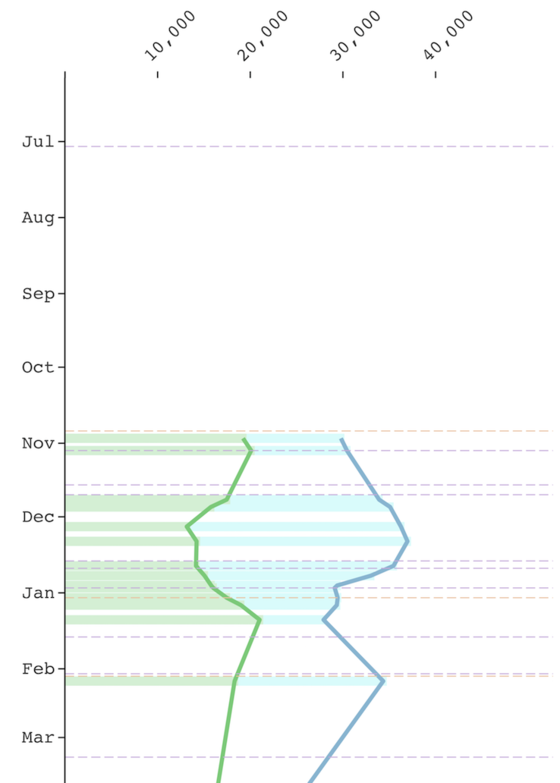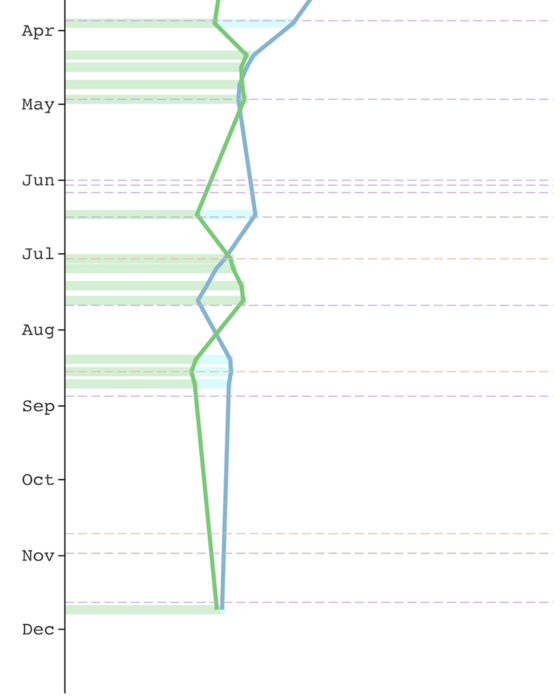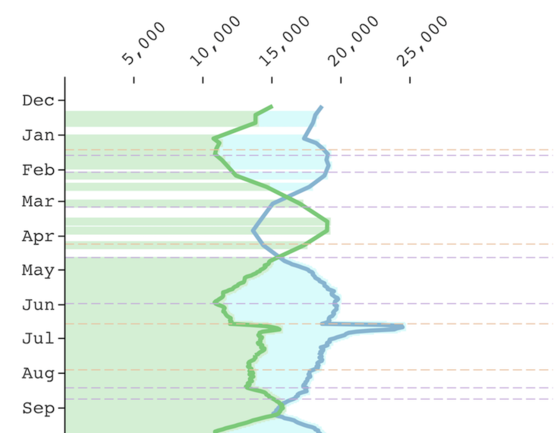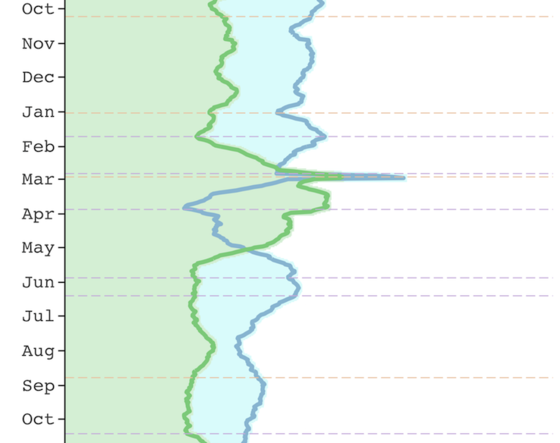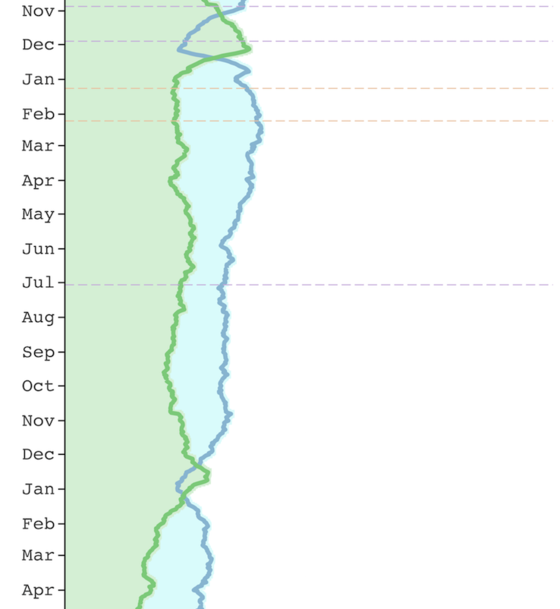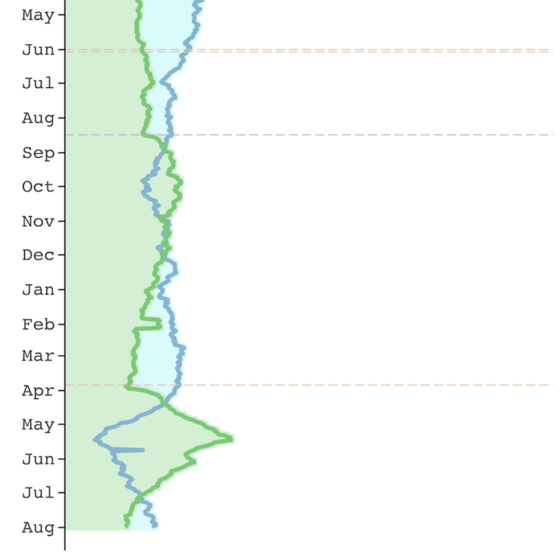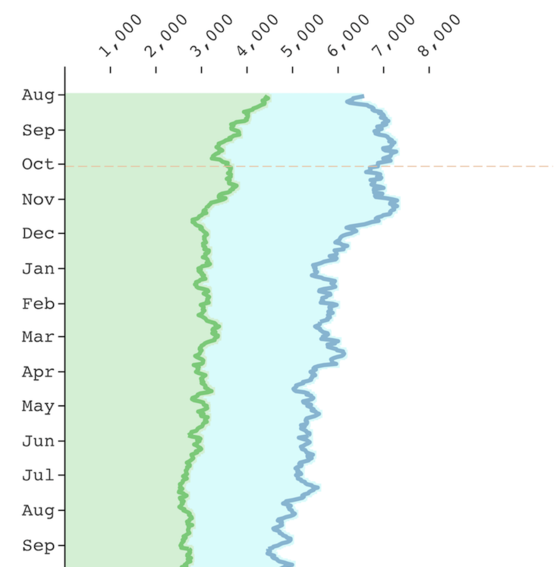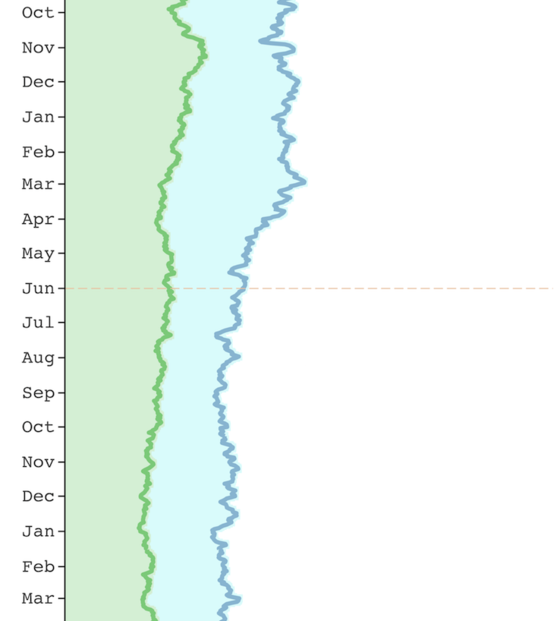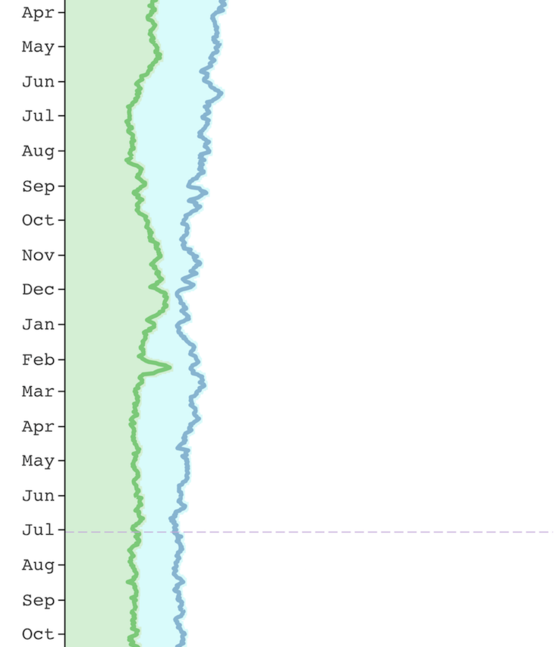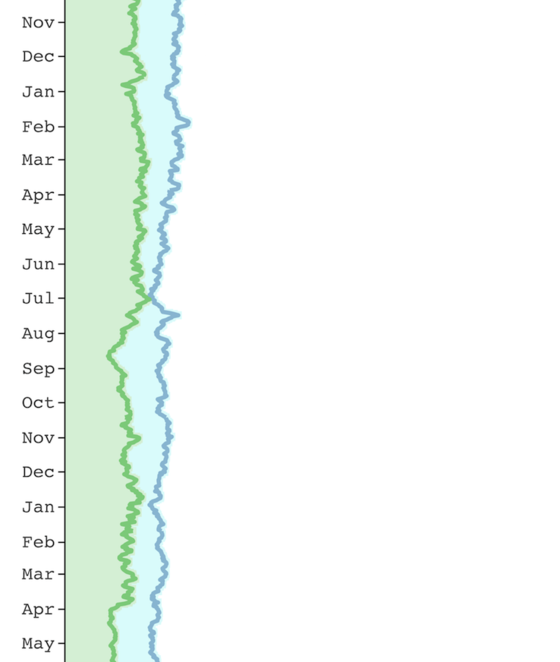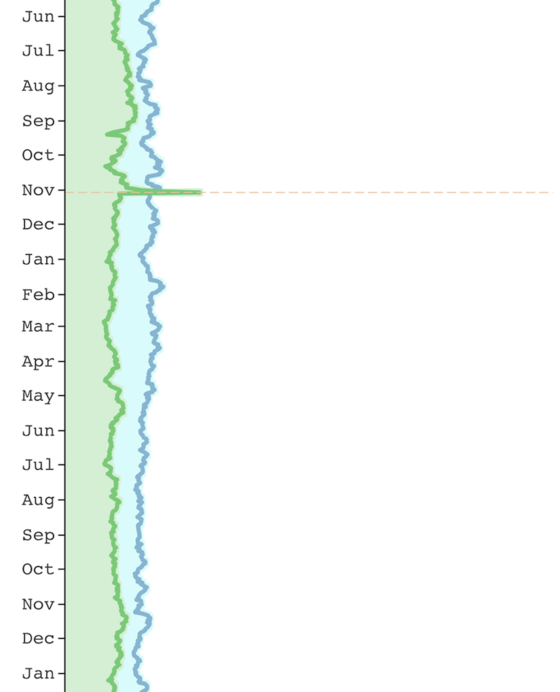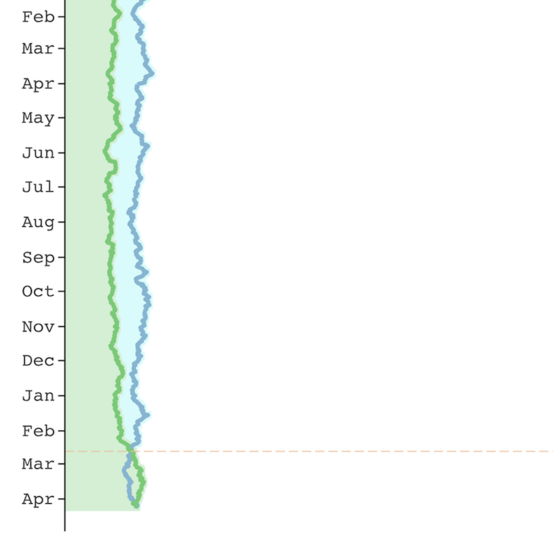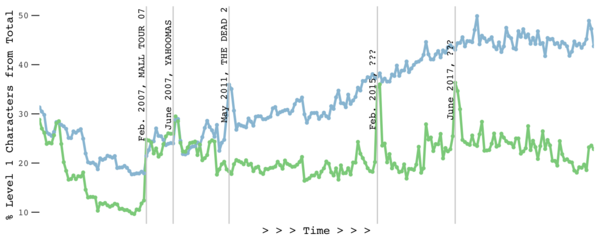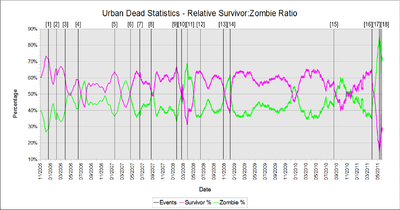Survivor-Zombie Imbalance: Difference between revisions
mNo edit summary |
(new level 1 Zerg graph. Some of the numbers and events don't match up as I would expect, so may need to check) |
||
| Line 484: | Line 484: | ||
Consider game [[Wikipedia:chemical equilibrium|equilibrium]]. Whenever a survivor is killed, they become zombies until they are revived. The rate at which survivors go through this process depends on how much AP it takes to kill them, to find syringes, find survivors to revive, and then revive them. But the game balance cannot be reduced to the math of AP efficiency. If dead survivors ''want'' to be alive, they [[Mrh Cow|go to revive points]], get revived, and try not to die again. This increases the rate at which survivors are revived, but it is based on player preference rather than the direct cost of AP. To drive the point home, if every player suddenly decides they only want to be zombies, then they purchase [[brain rot]] or jump out of buildings. This would greatly slow the rate at which zombies become survivors, increasing the relative abundance of zombies. If we really wanted to know how balanced the game is from an AP efficiency perspective, everyone would need to play as Dual Nature. | Consider game [[Wikipedia:chemical equilibrium|equilibrium]]. Whenever a survivor is killed, they become zombies until they are revived. The rate at which survivors go through this process depends on how much AP it takes to kill them, to find syringes, find survivors to revive, and then revive them. But the game balance cannot be reduced to the math of AP efficiency. If dead survivors ''want'' to be alive, they [[Mrh Cow|go to revive points]], get revived, and try not to die again. This increases the rate at which survivors are revived, but it is based on player preference rather than the direct cost of AP. To drive the point home, if every player suddenly decides they only want to be zombies, then they purchase [[brain rot]] or jump out of buildings. This would greatly slow the rate at which zombies become survivors, increasing the relative abundance of zombies. If we really wanted to know how balanced the game is from an AP efficiency perspective, everyone would need to play as Dual Nature. | ||
<Big><big><big>'''ZERGING'''</BIG></big></big> | |||
[[file:Level 1 graph.png|600px]] | |||
<div style="width:600px;text-align:left"> | |||
<big>'''Plot showing the percentage of level 1 characters compared to all other levels.'''</big><br> | |||
Level 1 characters include survivors (all classes) in blue and zombies in green. Time is scaled "loosely" because the data was obtained from the Wayback Machine; each data point is not necessarily separated by equal amounts of time. However, the data begins in late 2005 and ends in early 2021. | |||
Keep in mind that level 1 can be legitimately created as alts or by players new to the game, as well as en masse by zergers. Given the waning popularity of the game, fewer new players are expected to join. Therefore, the later timepoints more likely reflect efforts by zergers. | |||
A crude interpretation of this graph is that players have zerged more as time has gone on, especially survivors. A more nuanced position is that the zerging tends to be in the form of throwaway level 1 survivors, rather than zombies. The main exception are several spikes in level 1 zombies (some marked on the graph), who are either banned or level up, thus disappearing from this graph. | |||
</div> | |||
Revision as of 03:03, 27 March 2021
1
| ........... | 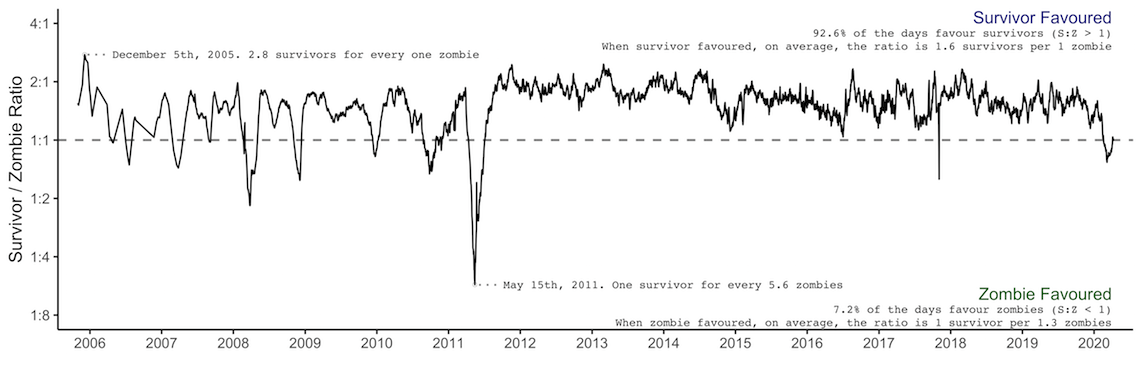
The Survivor / Zombie Ratio, December 2005 to April 2020. Data obtained from Urban Dead statistics, April 2017 to current day. Older data from the Wayback Machine was collected manually.3
2INTERPRETING THE GRAPHS The first graph shows the survivor-zombie ratio. The graph below shows the absolute survivor and zombie populations in a series of three parts: Early Day Volatility (EDV), The Swings (TW), and The Long Tail (TLT).4 These graphs go in-depth, listing most game updates and a small number of player-initiated events. While the game updates are listed regardless of their impact on the survivor-zombie ratio, partly due to the relative infrequency of the updates, the player events are (usually) listed if they seem to be responsible for a shift in the survivor-zombie ratio. An underlying assumption is that the ratio only changes if a force acts on it, be it a game update or player event. Although it often seems "obvious" that a game update or player event caused a shift in the ratio, it is impossible to identify all player events occurring at a given time; not all have been written into history. And given a specific time point, multiple events could be happening at the same time. How do we determine the degree to which each event influenced the ratio? Sometimes, however, an event is so large that it undeniably caused a change in the ratio. Call it a natural experiment. All that said, the purpose of the following in-depth graph is to chronicle the game balance over the years, without pointing too many fingers. 3CAVEATS
4WHY ISN'T [INSERT EVENT HERE] ON THE GRAPH? The graph maker may have missed an important game event (and it should be included). But it's also important to minimize the number of events and game updates on the page, as there's only so much room available. Larger scale events, such as roaming hordes and "big picture" moments in history (e.g., protests) are typically included. While some events clearly had no impact on the ratio, such as The Big Bash 4, they are still listed here. This is mainly included for the reader's interest, since the earlier versions of events tended to have a stronger impact. A few second city events are included for interest, even though their respective populations are not present in Malton's statistics. Some of the simpler or cosmetic game updates are also not mentioned, such as bug fixes, server upgrades, and unofficial changes (example).
5EARLY DAY VOLATILITY The first year or so of Urban Dead's history was marked by rapid game updates, establishing fundamental mechanics that flattened the ratio close to equality. These changes came quickly on the heels of social upheaval, the kind consisting of protests, violent riots, and roaming zombie hordes. It was an energetic, though uncertain time.
8CONCLUSION The ratio stabilized as time went on. By The Long Tail, there were three survivors for every two zombies. (To be precise, it's an average of 1.55 survivors per zombie over the entire game history.) Is this a sign of game imbalance? Of course, "it depends." What things should look like is an opinion (pick one, none, or more):
The opinion of this author: the ratio favours survivors because they have more things to do and are more fun to play. The AP efficiency of actions is secondary to this. The fact that players choose the side they want to play damages the idea that AP efficiency is the cause for the relative overabundance of survivors... with the exception of the few and far between Dual Nature players. Consider game equilibrium. Whenever a survivor is killed, they become zombies until they are revived. The rate at which survivors go through this process depends on how much AP it takes to kill them, to find syringes, find survivors to revive, and then revive them. But the game balance cannot be reduced to the math of AP efficiency. If dead survivors want to be alive, they go to revive points, get revived, and try not to die again. This increases the rate at which survivors are revived, but it is based on player preference rather than the direct cost of AP. To drive the point home, if every player suddenly decides they only want to be zombies, then they purchase brain rot or jump out of buildings. This would greatly slow the rate at which zombies become survivors, increasing the relative abundance of zombies. If we really wanted to know how balanced the game is from an AP efficiency perspective, everyone would need to play as Dual Nature.
Plot showing the percentage of level 1 characters compared to all other levels. Keep in mind that level 1 can be legitimately created as alts or by players new to the game, as well as en masse by zergers. Given the waning popularity of the game, fewer new players are expected to join. Therefore, the later timepoints more likely reflect efforts by zergers. A crude interpretation of this graph is that players have zerged more as time has gone on, especially survivors. A more nuanced position is that the zerging tends to be in the form of throwaway level 1 survivors, rather than zombies. The main exception are several spikes in level 1 zombies (some marked on the graph), who are either banned or level up, thus disappearing from this graph.
SEE ALSO
|
